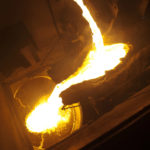Heat treatment is defined as an operation involving the heating and cooling of a metal or an alloy in the solid-state to obtain certain desirable properties without change composition.
The process of heat treatment is carried out to change the grain size, to modify the structure of the material, and to relieve the stresses set up the material after hot or cold working.
The heat treatment is done to improve the machinability.
To improve magnetic and electrical properties.
To increase resistance to wear, heat and corrosion, and much more reason.
Heat treatment consists of heating the metal near or above its critical temperature, held for a particular time at that finally cooling the metal in some medium which may be air, water, brine, or molten salts. The heat treatment process includes annealing, case hardening, tempering, normalizing and quenching, nitriding, cyaniding, etc.
Checkout: The Complete List of Mechanical Properties of materials
Types of Heat Treatment Processes
Following are the different types of heat treatment processes:
- Annealing
- Normalizing
- hardening
- Tempering
- Nitriding
- Cyaniding
- Induction Hardening
- Flame Hardening
Types of Heat Treatment
1 Annealing
Annealing is one of the most important processes of heat treatment. It is one of the most widely used operations in the heat treatment of iron and steel and is defined as the softening process.
Heating from 30 – 50°C above the upper critical temperature and cooling it at a very slow rate by seeking it the furnace. The main aim of annealing is to make steel more ductile and malleable and to remove internal stresses. This process makes the steel soft so that it can be easily machined.
1.1 Purpose of Annealing
- It softens steel and to improve its machinability.
- To refine grain size and remove gases.
- It removes the internal stresses developed during the previous process.
- To obtain desired ductility, malleability, and toughness.
- It modifies the electrical and magnetic properties.
1.2 Procedure for Annealing
Depending on the carbon content, the steel is heated to a temperature of about 50° to 55°C above its critical temperature range. It is held at this temperature for a definite period of time depending on the type of furnace and nature of work. The steel is then allowed to cool inside the furnace constantly.
Read more: Heat treatment of steel Why It Is Important Factor In Manufacturing






